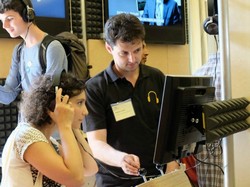New control of audio reverberation
Reverberation means for sound to persist after being produced; physically similar to echo, reverberation differs in that numerous reflections arrive at nearly the same time. Dereverberation is the process of removing reverberation. The EU-funded DREAMS(opens in new window) (Dereverberation and reverberation of audio, music, and speech) project combined research and training in the field of reverberation and dereverberation. Specifically, the team studied problems concerning modelling, controlling, removing and synthesising acoustic reverberation. The purpose was to enhance the quality and intelligibility of audio, music and speech signals. DREAMS was set up to provide researcher training and secondments, via which researchers gained experience internationally and across sectors. The consortium hosted 12 early-stage and 4 experienced researchers. All conducted an individual research project on one of four themes representing the most challenging problems facing the field. The room acoustics study involved development of new models and establishment of interconnections with existing models. The team identified perceptually relevant attributes for small-room and car-cabin acoustics. Researchers also developed perceptually meaningful approximations of room acoustics models. Lastly, the group designed accurate, scalable algorithms for microscopic and macroscopic room models. The study of psychoacoustics detailed the perceptual impact of reverberation and dereverberation on speech and audio signals. The team thus modified dereverberation algorithms. Other key achievements included evaluation and rating of measures for intelligibility and quality of reverberated speech, and new design methodologies. Theme three involved designing algorithms capable of compensating for reverberation in combination with other acoustics artefacts such as noise. The team developed algorithms for dereverberation, echo cancellation and noise reduction, plus coding schemes for data compression. Lastly, researchers developed new and efficient algorithms for dereverberation and similar inverse acoustic problems. The algorithms processed sound source localisation, sound field control, dereverberation and room impulse response interpolation. Apart from research, training involved seasonal schools, including application sessions, and non-technical career development courses. The project also organised a dedicated conference and special sessions at related conferences. DREAMS achieved successful researcher training in the field of audio reverberation and dereverberation. The work has yielded improved algorithms that will contribute to better-performing audio devices.







